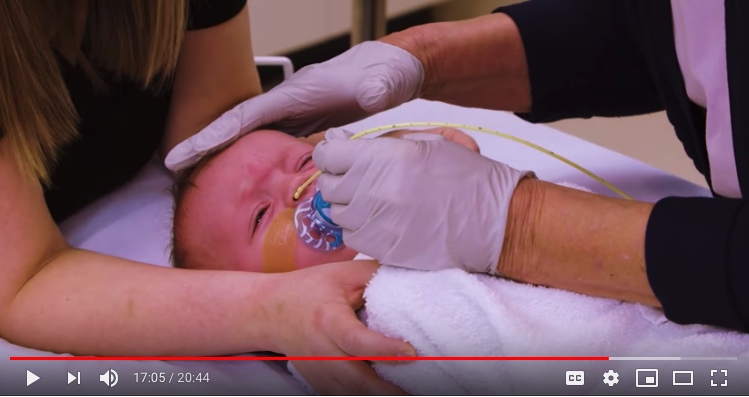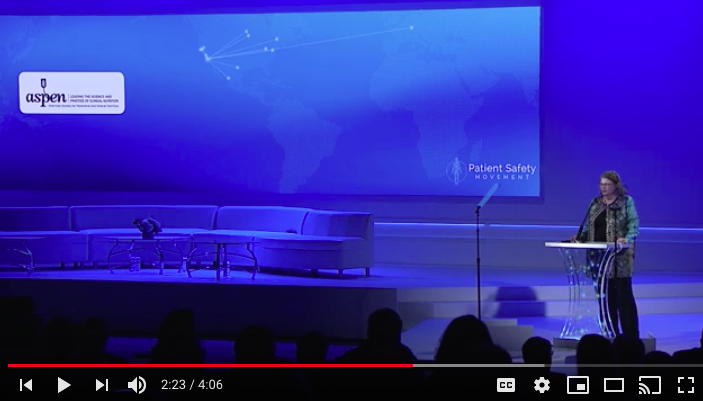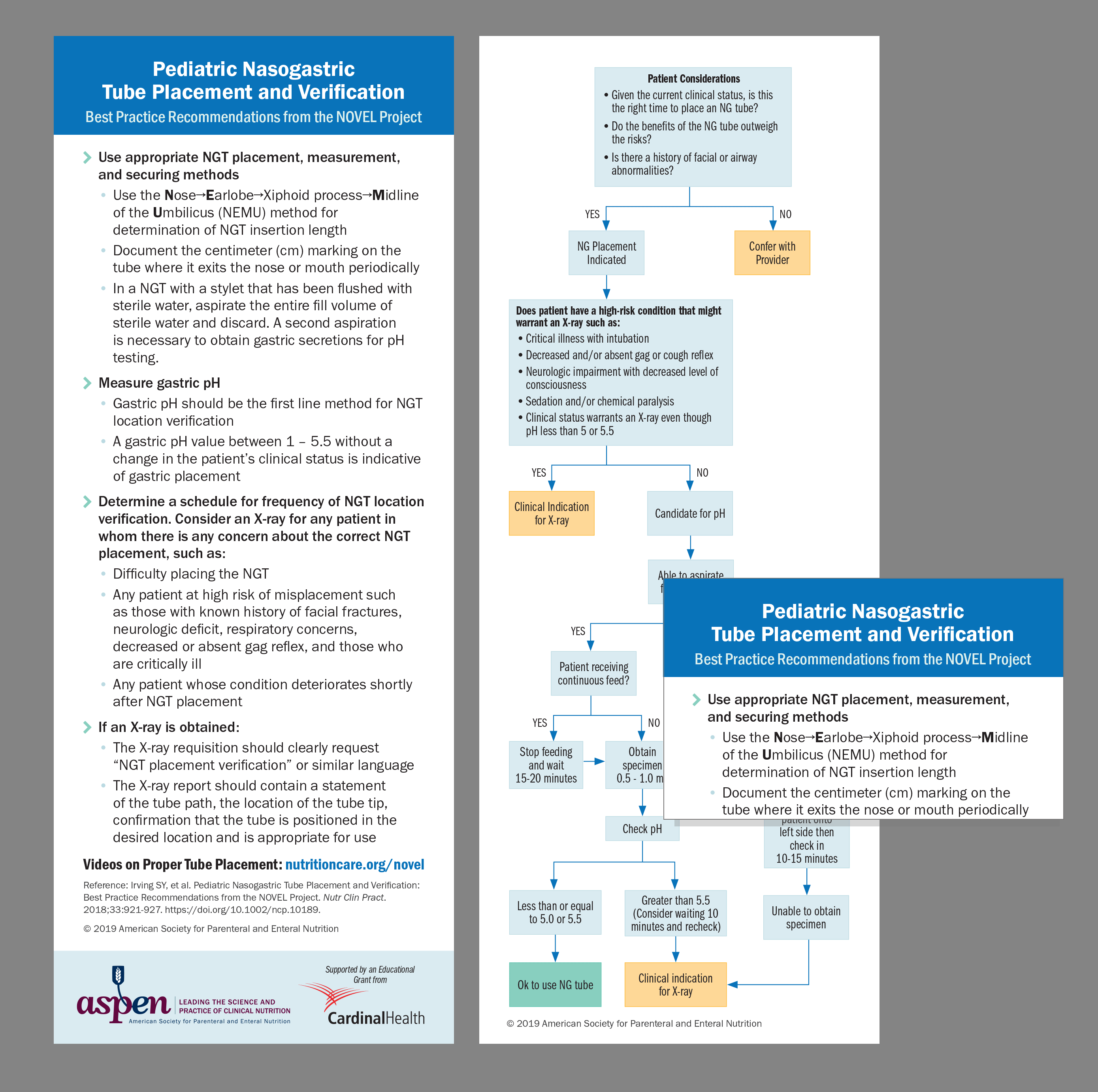New Opportunities for Verification of Enteral Tube Location Project
The NOVEL Project was launched to address an important issue—what is the best practice to verify nasogastric (NG) feeding tube location in pediatrics? NG tube misplacement can cause serious harm and/or death to patients. X-rays can be used to verify proper tube placement, but with pediatric patients, NG tubes can be removed several times a day. The use of x-rays to verify every tube placement can overexpose these patients to radiation.
NOVEL Videos
 The NOVEL Project task force has created two audience-specific videos highlighting best practices for inserting and verifying the placement of NG tubes in pediatric patients. Please use these videos to train clinicians and caregivers caring for pediatric patients.
The NOVEL Project task force has created two audience-specific videos highlighting best practices for inserting and verifying the placement of NG tubes in pediatric patients. Please use these videos to train clinicians and caregivers caring for pediatric patients.
Pediatric Nasogastric Tube Placement and Verification: An Instructional Video for Professionals
Pediatric Nasogastric Tube Placement and Verification: An Instructional Video for Caregivers
These videos were made possible due to a generous grant from Cardinal Health.
ASPEN Announces New NOVEL Tools at Patient Safety Movement Meeting
 Beth Lyman, former chair of the NOVEL project represented ASPEN at the recent Patient Safety Movement Foundation (PSMF) 7th Annual Patient Safety, Science & Technology Summit. Her talk outlined the ASPEN commitment to patient safety and zero preventable deaths. The NOVEL project work supports the PSMF Actionable Patient Safety Solution of NG tube placement and verification.
Beth Lyman, former chair of the NOVEL project represented ASPEN at the recent Patient Safety Movement Foundation (PSMF) 7th Annual Patient Safety, Science & Technology Summit. Her talk outlined the ASPEN commitment to patient safety and zero preventable deaths. The NOVEL project work supports the PSMF Actionable Patient Safety Solution of NG tube placement and verification.
NOVEL Lanyard/Pocket Cards
 This small laminated reference card summarizes the recommended best practices from the NOVEL Project. It also includes a decision tree on when gastric pH measurement should be used and when X-ray is indicated. These quick reference cards have been designed to fit into a clinician’s lanyard badge holder, pocket, or wallet.
This small laminated reference card summarizes the recommended best practices from the NOVEL Project. It also includes a decision tree on when gastric pH measurement should be used and when X-ray is indicated. These quick reference cards have been designed to fit into a clinician’s lanyard badge holder, pocket, or wallet.
Download a PDF of the card
Download a printer-ready version
Publications on NOVEL Project
Pediatric Nasogastric Tube Placement and Verification: Best Practice Recommendations From the NOVEL Project. Nutrition in Clinical Practice. 2018;33:921-927
Use of Nasogastric Feeding Tubes for Children at Home: A Template for Caregiver Education. Nutr Clin Pract. 2017;32 (6): 831–833.
Current Practices in Home Management of Nasogastric Tube Placement in Pediatric Patients: A Survey of Parents and Homecare Providers. Journal of Pediatric Nursing. 2017;33:46–53.
Use of Temporary Enteral Access Devices in Hospitalized Neonatal and Pediatric Patients in the United States. J Parenter Enteral Nutr. 2016;40 (4): 574–580.
Verifying NG tube placement in children. Nursing2015;45(10):8.
A Call to Action: The Development of Enteral Access Safety Teams. Nutr Clin Pract. June 2014; 29(3):264–266.
Nasogastric Tube Placement and Verification in Children: Review of the Current Literature. Copublished in Nutr Clin Pract. and Critical Care Nurse 2014; 29(3):267–276.
NOVEL Newsletters
Issue 11. January 2024
Issue 10, January 2023
Issue 9, December 2021
Issue 8, January 2021
Issue 7, December 2019
Issue 6, December 2018
Issue 5, January 2018
Issue 4, December 2016
Issue 3, December 2015
Issue 2, March 2015
Issue 1, November 2014
ASPEN Novel Project Update, May 12, 2014
NOVEL Project Goes International, May 5, 2014
NOVEL Task Force
Formed in 2012, the NOVEL project task force:
- Works with biomedical engineers and industry to develop non-radiologic method(s) to verify NG tube placement and to allow for re-verification of placement
- Collaborates with specialty nursing organizations to determine best practices for determining NG tube location working with existing technology and accepted procedures such as pH measurements
- Fosters the discovery of new knowledge and science and its application to the field of nutrition support (NS) therapy
- Disseminates knowledge that improves clinical practice pertaining to NG tube placement verification
- Advocates on behalf of the field of NS to improve patient outcomes and clinical practice
- Promotes consistency of practice among individual nurses and pediatric acute care centers
Members:
- Beth Lyman, MSN, RN, CNSC (Project Chair, representing ASPEN)
- Peggi Guenter, PhD, RN, FAAN, FASPEN, ASPEN Staff
- Sharon Irving PhD, CRNP, FCCM, FAAN; University of Pennsylvania School of Nursing (representing AACN)
- Carol Kemper PhD, RN; Children’s Mercy Kansas City (representing Patient Safety Officers)
- Candice Moore, BSN, RN; Cincinnati Children’s Hospital (representing home care)
- LaDonna Northington RN, DNS; University of Mississippi School of Nursing (representing Society of Pediatric Nursing)
- Rosemary Pauley, APRN, MS; Boys Town National Research Hospital (representing Association of Pediatric Gastroenterology and Nutrition Nurses (APGNN)
- Gina Rempel MD, FRCPC, FAAP; Children’s Hospital Winnipeg (representing ASPEN and international members)
- Wednesday Sevilla, MD, MPH, CNSC; Children’s Hospital of Pittsburgh, UPMC (representing ASPEN)
- Kerry Wilder, RN, MBA from Texas Scottish Rite Hospital (representing NANN)
- Deahna Visscher; Parent Representative and Safety Advocate Denver, CO
Get Involved!
- Volunteer to help with the NOVEL Project. Contact Beth Lyman at [email protected]
- Analyze your own institution and how nasogastric tube location is determined
Related ContentOther ASPEN resources on Enteral Nutrition and Pediatrics:
|